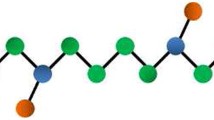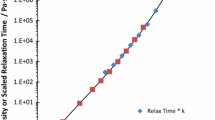Abstract
It is essential to the establishment of EHL as a quantitative field, that reference materials be selected and accurately characterized so that calculations may be compared with experiment. Three materials were selected as somewhat representative of the viscosity dependence on temperature, pressure and shear that may be observed in EHL lubrication:
-
1.
Squalane
-
2.
Poly(ethylene glycol-ran-propylene glycol)
-
3.
Squalane +15% by weight of Polyisoprene, cis.
The properties of these materials were measured over a range of temperature and pressure using experimental techniques which have been shown to give accurate measurements for presently established reference materials. Models are provided for use in elastohydrodynamic simulations.










Similar content being viewed by others
Abbreviations
- a V :
-
thermal expansivity defined for volume linear with temperature, K−1
- B :
-
Doolittle parameter
- D F :
-
fragility parameter in the VTF equation
- G :
-
liquid critical shear stress or material modulus associated with λ, Pa
- h :
-
film thickness, m
- K :
-
isothermal bulk modulus, Pa
- K 0 :
-
isothermal bulk modulus at p = 0, Pa
- K ′0 :
-
pressure rate of change of isothermal bulk modulus at p = 0
- K 00 :
-
K 0 at zero absolute temperature, Pa
- m :
-
exponent for a shifting rule
- N 1 :
-
first normal stress difference, the tension in the flow direction minus the tension in the cross-film direction, Pa
- N 2 :
-
second normal stress difference, the tension in the cross-film direction minus the tension in the neutral direction, Pa
- n :
-
power-law exponent
- p :
-
pressure, Pa
- R 0 :
-
occupied volume fraction at reference state, T R, p = 0
- T :
-
temperature, K
- T ∞ :
-
divergence temperature, K
- T R :
-
reference temperature, °C
- V :
-
volume at T and p, m3
- V R :
-
volume at reference state, T R, p = 0, m3
- V 0 :
-
volume at p = 0, m3
- V ∞ :
-
occupied volume, m3
- V ∞R :
-
occupied volume at reference state, T R, p = 0, m3
- α:
-
local pressure–viscosity coefficient, Pa−1
- α0 :
-
initial pressure–viscosity coefficient, Pa−1
- α*:
-
reciprocal asymptotic isoviscous pressure coefficient (=1/p ai), Pa−1
- αB :
-
secant pressure–viscosity coefficient, Pa−1
- αfilm :
-
general film-forming pressure–viscosity coefficient, Pa−1
- β K :
-
temperature coefficient of K 0, K−1
- \(\dot{\gamma}\) :
-
shear rate, s−1
- ɛ:
-
occupied volume thermal expansivity, K−1
- η:
-
rate-dependent shear viscosity, Pa s
- λ:
-
characteristic or relaxation time, s
- μ:
-
limiting low-shear viscosity and Newtonian viscosity, Pa s
- μR :
-
low-shear viscosity at reference state, T R, p = 0, Pa s
- μ∞ :
-
viscosity extrapolated to infinite temperature, Pa s
- ρ:
-
mass density, kg/m3
- ρR :
-
mass density, at reference state, T R, p = 0, kg/m3
- σ:
-
regression fit quality, \(\sqrt {\sum\limits_1^N {{{{{[(x_{{\text{meas}}} - x_{{\text{calc}}} )} \mathord{\left/ {\vphantom {{[(x_{{\text{meas}}} - x_{{\text{calc}}} )} {x_{{\text{meas}}} ]^2 }}} \right. \kern-\nulldelimiterspace} {x_{{\text{meas}}} ]^2 }}} \mathord{\left/ {\vphantom {{{{[(x_{{\text{meas}}} - x_{{\text{calc}}} )} \mathord{\left/{\vphantom {{[(x_{{\text{meas}}} - x_{{\text{calc}}} )} {x_{{\text{meas}}} ]^2 }}} \right. \kern-\nulldelimiterspace} {x_{{\text{meas}}} ]^2 }}} N}} \right. \kern-\nulldelimiterspace} N}}}\)
- τ:
-
shear stress, Pa
References
R.L. Fusaro, Tribology Needs for Future Space and Aeronautical Systems. NASA Technical Memorandum 104525:2
Bair S. (2000) Proc. Instn. Mech. Engrs. 214(Part J):515
Kleinschmidt R.V., Bradbury D., Mark M., (1953). Viscosity and Density of Over Forty Lubricating Fluids of Known Composition at Pressures to 150,000 psi and Temperatures to 425 F. ASME, New York
J.A. Dixon, W. Webb, W.A. Steele, Properties of Hydrocarbons of High-Molecular Weight Synthesized by Research Project 42 of the American Petroleum Institute. Pennsylvania State University (1962)
Crook A.W., (1963) Phil. Trans. Roy. Soc. Lond., Series A 255(1056): 281
C.J.A. Roelands, Correlational Aspects of the Viscosity–Temperature–Pressure Relationship of Lubricating Oils, Ph.D. thesis (University of Technology, Delft, 1996) 94
Sorab J., Vanarsdale W.E., (1991) STLE Trib. Trans. 34(3): 604
Harris T.A., Barnsby R.M., (2001) Instn. Mech. Engrs. 215(Part J):577
Paluch M., Denzik Z., Rzoska S.J., (1999) Phys. Rev. B 60(5):2979
Novak J.D., Winer W.O., (1968) ASME J. Lubr. Techn. 90(Ser. F, No. 3):580
Johnston G.J., Wayte R., Spikes H.A., (1991) STLE Trib. Trans. 34(2):187
M. Hartl, J. Molimard, I. Krupka, P. Vergne, M. Querry, R. Poliscuk and M. Liska, in: Thinning Films and Tribological Interfaces. D. Dowson et al. (eds), (Elsevier, 2000) pp. 695–704.
Glovnea R.P., Olver A.V., Spikes H.A., (2005) STLE Trib. Trans. 48: 328
Bair S., Vergne P., Querry M., (2005) Trib. Lett. 18(2):145
Bair S., McCabe C., Cummings P.T., (2002) Tribol. Lett.13(4): 251
Bair S., Qureshi F., (2002) STLE Tribol. Trans. 45:390
Harris K.R., (2000) J. Chem. Eng. Data 45(3):893
Caetano F.J.P., Fareleira J.M.N.A., Oliveira C.M.B.P., Wakeham W.A., (2005) J. Chem. Eng. Data 50(6):1875
Caudwell D.R., Trusler J.P.M., Vesovic V., Wakeham W.A., (2004) Int. J. Thermophys. 25(5):1339
Bair S. (2004), STLE Trib. Trans. 47(3):356
Walker I.R., (1999) Rev. Sci. Instruments 70(8):3402
C.R. Schultheisz, S.D. Leight, Certification of the Rheological Behavior of SRM 2490, Polyisobutylene Dissolved in 2,6,10,14-Tetramethylpentadecane, NIST Special Publication 260-143 (2002)
Kottke P., Bair S.S., Winer W.O., (2005) AICHE J. 51(8):2150
Bair S., (1996) Rheol. Acta 35:13
Whorlow R.W., (1980) Rheological Techniques. Wiley, New York, p. 45
Bair S., Jarzynski J., Winer W.O., (2001) Tribol. Int. 34(7): 461
P.W. Bridgman (1970), The Physics of High Pressure. Dover, New York, p. 128
S. Bair, Y. Liu, Q.J. Wang, The Pressure–Viscosity Coefficient for Newtonian EHL Film Thickness with General Piezoviscous Response. ASME paper Trib-05-1170 (2006)
Angell C.A., (1995) Science 276:1924
Bair S., McCabe C., Cummings P.T., (2002) Phys. Rev. Lett. 88(5):058302-1
McCabe C., Bedrov D., Borodin O., Smith G.D., Cummings P.T., (2003) Ind. Eng. Chem. Res. 42(6):6956
Tanner R.I., (2000) Engineering Rheology, 2nd ed. Oxford University Press, Oxford, p. 160
McDonald J.R., (1966) Rev. Modern Phys. 38(4): 699
Fakhreddine Y.A., Zoller P., (1990) J. Appl. Polymer Sci. 41:1087
Fandino O., Pensada A.S., Lugo L., Comunas M.J.P., Fernandez J. (2005) J. Chem. Eng. Data 50:939
Cook R.L., King H.E., Herbst C.A., Herschbach D.R., (1994). J. Chem. Phys. 100(7):5178
Paluch M., Denzik Z., Rzoska S.J., (1999) Phys. Rev. B 60(5):2979
Greenwood J.A., (2000) Proc. Instn. Mech. Engrs. 214(Part J):29
S. Bair, M. Kotzalas, The Contribution of Roller Compliance to Elastohydrodynamic Traction. STLE Trib. Trans. 49(2)(2006) 218
Acknowledgment
The measurements reported here were supported by a grant from the Timken Company. The design and construction of the high-pressure rheogoniometer was funded by a grant from Valvoline Corporation.
Author information
Authors and Affiliations
Corresponding author
Rights and permissions
About this article
Cite this article
Bair, S. Reference liquids for quantitative elastohydrodynamics: selection and rheological characterization. Tribol Lett 22, 197–206 (2006). https://doi.org/10.1007/s11249-006-9083-y
Received:
Accepted:
Published:
Issue Date:
DOI: https://doi.org/10.1007/s11249-006-9083-y




